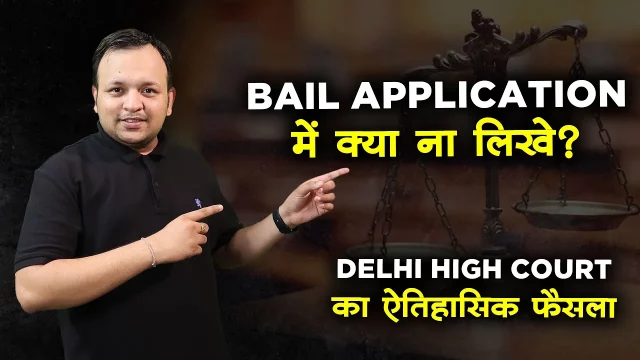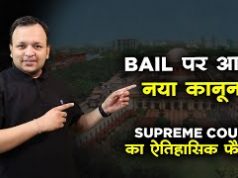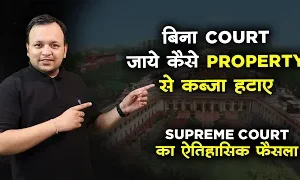‘Bail is the rule, jail is an exception is a legal principle that was laid down by the Supreme Court in a landmark judgment of the State of Rajasthan vs. Balchand @ Baliya in 1978.
A bail application is drafted with a very common view that if we mention the reference of several judgments the bail will be granted easily but this is a complete misconception and there is no essence in this. This was clarified recently by the Hon’ble Delhi High Court in the Landmark Judgement of Aakash Choudhary vs. the State (NCT of Delhi) & Anr. on September 15, 2022. The Hon’ble Court highlighted several important points to be remembered by an advocate while drafting a bail application under Section 438 or 439 of Cr.P.C. and also basic principles of drafting as per the Delhi High Court.
The Landmark Judgement of Aakash Choudhary vs. The State (NCT of Delhi) & Anr.
In this case, the Hon’ble Delhi High Court after hearing the bail application and before completing the judgment the Hon’ble Judge stated a very crucial point of basic principles of drafting in Para 25 which is mentioned below:
“25. It has been noticed that in the bail applications, apart from stating the facts, elaborate extracts from judgments have been made part of the pleadings. The learned drafting counsel is requested to adhere to the basic principles of pleading and state only facts and the legal provisions applicable along with the grounds on which the bail has been sought. As far as the citations are concerned, the counsels are at liberty to cite all relevant judgments at the time of the arguments. There is no need to attach copies of the judgments with the pleadings, which results in making the pleadings too bulky. These citations may be handed over to the Court Master at the time of arguments or they may be filed online just before the petitions are listed for final arguments. I earnestly hope that the learned drafting counsels will bear this in mind in the future.”
The Hon’ble Court emphasized the three important pillars of bail application i.e facts, relevant sections, and grounds on which the arguments will be conducted which constitute basic principles of a bail application. Never cite a judgment in the bail application, if the Advocate wants to rely on any judgment then he can simply provide a copy of the same to the court master during the argument so that he may present it to the Hon’ble Judge.
Necessary contents of a Bail application
The bail application is the simplest draft and there is as such no complexity in the drafting of the same. For convenience following are the necessary contents of the bail application:
- First, the name of the Court under whom the bail application is filed.
For eg. “IN THE COURT OF ______, ADDITIONAL DISTRICT AND SESSION JUDGE,_______”
- Second, the name of the client/petitioner along with the father/mother’s name, age, and address. It is very important to mention the correct name taking exact details from any identity proof of the client because even if the bail is granted the person may not be released from jail because of an error in the name.
- Third, after the name of the petitioner if the application is under Section 439 of Cr.P.C. mention the name of the jail whether it is the central jail, sub-jail or district jail in which the petitioner is in custody.
- Fourth, the Title of the application i.e. whether the application is under Section 439 or Section 438 followed by if the bail is presented before the Magistrate then it is relevant to mention that under Section 437 of the Cr.P.C. the bail application is submitted against the FIR (mention the FIR number) and relevant sections. Further, if the bail application is filed challenging the order of any subordinate court in the High court then mention the details and the date of the order which is to be challenged. For eg.
“S.B. CRIMINAL MISC. BAIL APPLICATION UNDER SECTION – 439 CR.P.C. AGAINST THE ORDER DATED _____ PASSED BY SHRI ____, LEARNED SESSIONS JUDGE, IN BAIL APPLICATION NO. _____ ARISING OUT OF F.I.R. NO. ______ FILED IN P.S. _______ FOR THE OFFENCES FALLING UNDER SECTIONS _____.”
- Fifth, the Facts of the case are mentioned after the title, in this, you need to mention the crux of the allegations imposed against the petitioner in the FIR and the date from which he was taken under custody and put in jail. Further, mention the details of the order of the subordinate court aggrieved by which you have approached the High Court for relief.
- Sixth, the Grounds of the Case are mentioned after the facts like those which can be favorable for granting bail to the petitioner and some common grounds are there for eg.
- That the applicant is having good antecedents, belongs to a good family, and has no criminal cases pending against him.
- That the applicant is a permanent resident and there is no chance of absconding from the course of justice.
- That the applicant undertakes to present before the court or police whenever required to.
- That the applicant undertakes that he will not directly or indirectly, make any inducement, threat, or promise to any person acquainted with the facts of the case to dissuade him to disclose any such facts to the court or the police officer.
- Seventh, Prayer is mentioned in which the counsel humbly requests for a grant of bail on the bases of grounds mentioned in the application and the other order which the court may deem fit and proper in the facts and circumstances of the case may be also passed in the favour of the applicant.
If doubts still persist, contact our Legal Experts at












